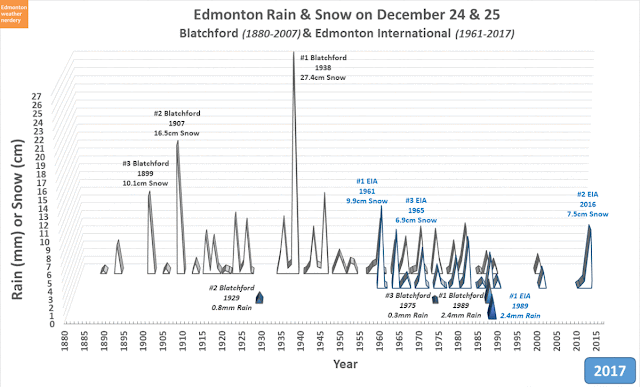
December 30th is quite late for our first -20°C, and last year was also quite late on December 24th. In 2016 it was a few weeks earlier on December 7th, and the 6 years from 2010-2015 all had their first -20°C days in November.
Since 1880 the "average" day of the first -20°C has moved around a bit: in the 1880s it was late-November; in the 1930s it was up around mid-November; in the early 2000s it was mid-December; and right now our average is the end of November.
Since 1880 there have only been 8 winters where Edmonton made it all the way through November & December without recording a Low of -20°C:
- 1918-1919
- 1952-1953
- 1953-1954
- 1969-1970
- 1974-1975
- 1987-1988
- 1997-1998
- 2002-2003
The winter of 2002-2003 was the latest, making it all the way to January 11th.
This chart also shows the date of the first -25°C.
Sometimes -25°C follows right behind the first -20°C, and other times there is a big gap. The largest gap was 1930-1931, with -20°C showing up early on October 19, and then 144 days later -25°C hitting very late on March 11. 1991-1992 was similar, getting it's first -20°C on November 1, and then -25°C arrived 110 days later on February 20.
There was one winter in Edmonton that did not have any temperatures below -25°C, and that 1986-1987.
Coldsnaps
On average we get about 23 Lows of -20°C each winter. That can range from a mild winter like 2015-2016 which only had 6, up to our coldest recent winter 2010-2011 which had 48.
Last winter had a late first -20°C on December 24th, but by the end of the winter it had racked up 31 days at -20°C, which is on the higher side of things. So if we get a late start that doesn't guarantee that the rest of the winter will be warm.
(and for this chart I am assuming the December 31st 2018 is going to have an official Low of -19°C. If it actually comes in as -20°C then we would have 2 -20°C days so far this winter)
Cold Lows Each Month
This chart shows how many cold days we average each month, for both recent years (1996-2018) and the 20th Century.
We mostly made it through November & December without deepfreezes, and right now on-average Novembers have 1.4 -20°C days while Decembers have 6.2. January is the big month for -20°C days though, averaging 9.7, then February averages 4.7, and March drags winter out with another 2.6.
Comparing 1996-2018 to the 20th Century average (which includes 1901-2000, and isn't just for the super-cold 1900ish years) most of the months have dropped by 1/3 to 1/2.
January is also our peak month for -25°C days with 4.9, and -30°C with 1.4. So as we head into January we'll just need to see how it goes.
Cold Lows at the Airport
The airport is quite a bit colder than Blatchford, averaging about 40 days at -20°C each winter compared to the 23 at Blatchford.
0°C Highs Each Month
For cold days there's quite a bit of variation between recent years, and the past, and the airport. But for warm days things are a lot more consistent. Recently Blatchford has had more warm days each winter than it's 20th Century average or the airport, but the difference is usually only 1 or 2 days.
Chance of Extremes
And this chart is one that we looked at back in 'Tis the season of -20°C. And it's just a reminder that we're more likely to have a 0°C High than a -20°C Low at almost any point in the winter, except for the last week of December, and the first two weeks of January.
















